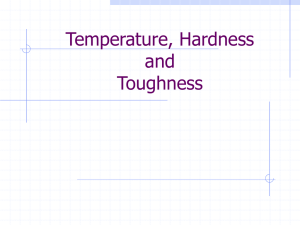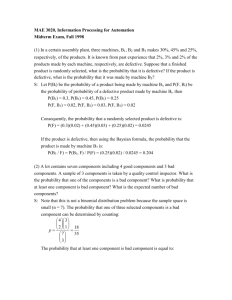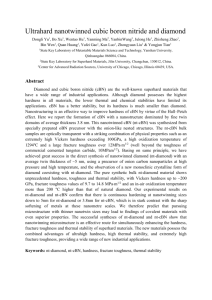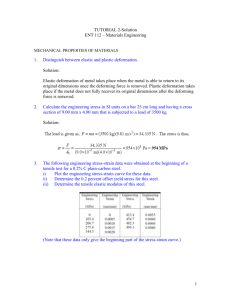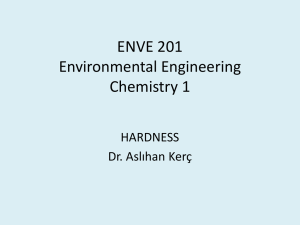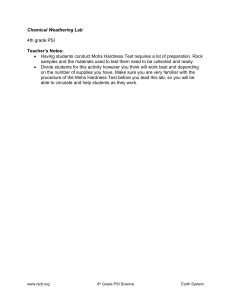Day_2DAS - Rose
advertisement
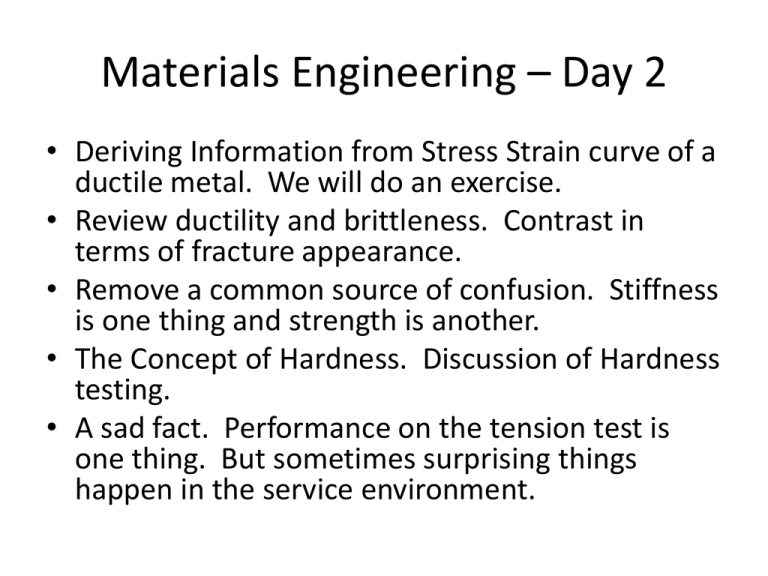
Materials Engineering – Day 2 • Deriving Information from Stress Strain curve of a ductile metal. We will do an exercise. • Review ductility and brittleness. Contrast in terms of fracture appearance. • Remove a common source of confusion. Stiffness is one thing and strength is another. • The Concept of Hardness. Discussion of Hardness testing. • A sad fact. Performance on the tension test is one thing. But sometimes surprising things happen in the service environment. Exercise • The exercise is a sample quiz question. Please plan to participate. • We will be comparing answers as we go. Ductile vs. Brittle Behavior • Let us look at some pictures of failure in metal. Here they are. • Notes on Brittle 1. Gross deformation is not great 2. Failure is by cleavage mechanism 3. Fracture surface is faceted and shiny • Notes on Ductile 1. Gross deformation is visible 2. Failure is by microvoid coalescence 3. Fracture surface is dimpled and dull Test: What type of fracture is this? Difference between Stiffness and Strength • Material A has E = 10x106 psi and UTS = 50 ksi • Material B has E = 30x106 psi and UTS = 35 ksi WHICH IS STRONGER? WHICH IS STIFFER? Summary • Stress and strain: These are size-independent measures of load and displacement, respectively. • Elastic behavior: This reversible behavior often shows a linear relation between stress and strain. To minimize deformation, select a material with a large elastic modulus (E or G). • Plastic behavior: This permanent deformation behavior occurs when the tensile (or compressive) uniaxial stress reaches sy. • Toughness: The energy needed to break a unit volume of material. • Ductility: The plastic strain at failure. 6 Hardness and Hardness Testing • What’s the problem with the tension test? 1. Expensive & complex 2. Destructive 3. Has to be done in the lab 4. Takes a while • This leads to a more simple characterization of material behavior, through the test for hardness. Hardness is resistance to indentation by a hard object like a needle or ball. Hardness • Resistance to permanently indenting the surface. • Large hardness means: --resistance to plastic deformation or cracking in compression. --better wear properties. apply known force measure size of indent after removing load e.g., 10 mm sphere d D most plastics brasses Al alloys easy to machine steels file hard Smaller indents mean larger hardness. cutting tools nitrided steels diamond increasing hardness 8 Hardness Testing Methods • Rockwell. 1) Apply preload. 2) Add main load and measure depth. 3) Remove main load and measure depth. Difference in depths is read out as a hardness. Machine for Testing Hardness (specimen placed On circular stage) Hardness: Resistance to Penetration/ Indentation/ Scratching Advantages Disadvantages can predict strength, wear resistance inexpensive, easy relatively nondestructive common designer specification strength prediction only quantitative for hard steel predictions are qualitative (no design numbers) Kinds of Hardness Tests • Rockwell A, B, and C. B is soft metals, C is for hard metals. Eg. Steel knife blade RC about 60. Crankshaft RC about 45. Values below 20 and above 100 RC are not reliable. Also superficial. • Brinell Hardness. Oldest measure. A steel (HBS) or tungsten (HBW) balls are used as indenters. You measure the diameter of the indentation and use a formula to get HB. UTS (psi) = 500 x BHN • Vickers. A diamond indenter is used. A very wide ranging scale. • Here is a comparison or more Hardness: Measurement Table 6.5 13 Hardness vs. Strength Correlate depending on metal UTS Cast Iron Steel: UTS = 500 BHN BHN


